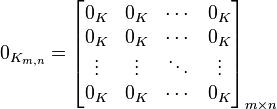Zero matrix
In mathematics, particularly linear algebra, a zero matrix or null matrix is a matrix with all its entries being zero.[1] Some examples of zero matrices are
The set of m×n matrices with entries in a ring K forms a ring  . The zero matrix
. The zero matrix  in
in  is the matrix with all entries equal to
is the matrix with all entries equal to  , where
, where  is the additive identity in K.
is the additive identity in K.
The zero matrix is the additive identity in  .[2] That is, for all
.[2] That is, for all  it satisfies
it satisfies
There is exactly one zero matrix of any given size m×n having entries in a given ring, so when the context is clear one often refers to the zero matrix. In general the zero element of a ring is unique and typically denoted as 0 without any subscript indicating the parent ring. Hence the examples above represent zero matrices over any ring.
The zero matrix represents the linear transformation sending all vectors to the zero vector.[3]
See also
- Identity matrix, the multiplicative identity for matrices
- Matrix of ones, a matrix where all elements are one
- Single-entry matrix, a matrix where all but one element is zero
References
- ↑ Lang, Serge (1987), Linear Algebra, Undergraduate Texts in Mathematics, Springer, p. 25, ISBN 9780387964126,
We have a zero matrix in which aij = 0 for all i, j. ... We shall write it O.
- ↑ Warner, Seth (1990), Modern Algebra, Courier Dover Publications, p. 291, ISBN 9780486663418,
The neutral element for addition is called the zero matrix, for all of its entries are zero.
- ↑ Bronson, Richard; Costa, Gabriel B. (2007), Linear Algebra: An Introduction, Academic Press, p. 377, ISBN 9780120887842,
The zero matrix represents the zero transformation 0, having the property 0(v) = 0 for every vector v ∈ V.


